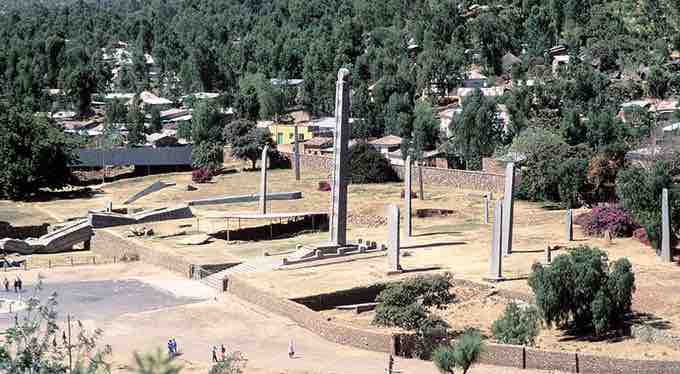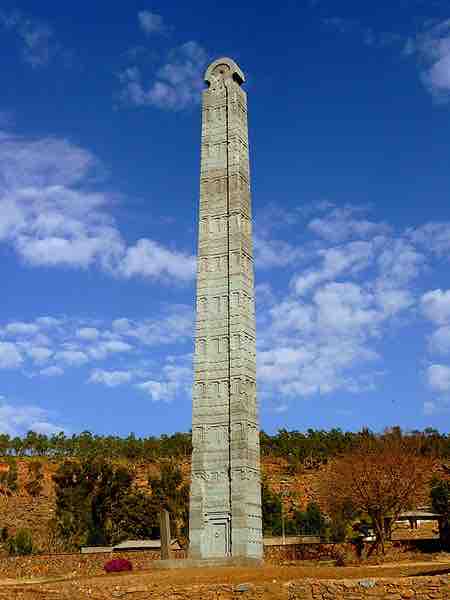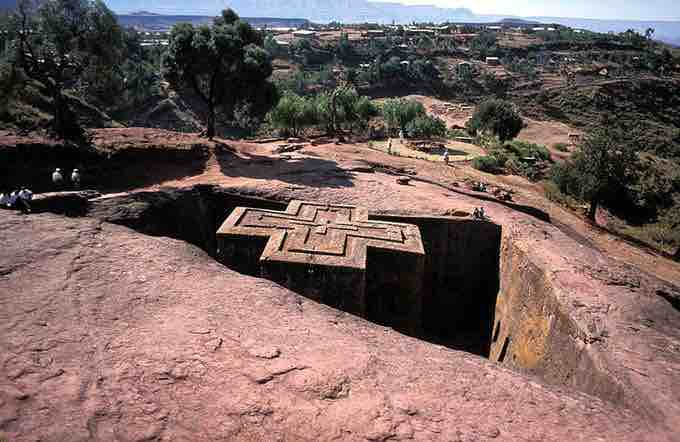Aksum
Aksum (sometimes spelled Axum) is a city in northern Ethiopia that was the original capital of the Kingdom of Aksum. A naval and trading power, the kingdom ruled the region from about 400 BCE to the tenth century, reaching its height under King Ezana (baptized as Abreha) in the fourth century.
The stelae are the most identifiable part of the Aksumite legacy. These stone towers served to mark graves and were often engraved with a pattern or emblem denoting the person's rank. The largest number are in the Northern Stelae Park, ranging to the grand size of the Great Stele (33 meters high, 2.35 meters deep, and 520 tons), which is believed to have fallen and broken during construction. The stelae have most of their mass above ground but are stabilized by massive underground counterweights.

The Northern Stelae Park at the town of Axum, Ethiopia
The stelae in Northern Stelae Park range to 33 meters high.
Aksum is best known for the 1937 discovery of the 24-meter tall, 1,700-year-old Obelisk of Axum. Broken into five parts and lying on the ground, it was found and shipped by Italian soldiers to Rome to be erected. The obelisk is widely regarded as one of the finest examples of engineering from the height of the Aksumite empire, and in 2005 it was finally returned to Aksum.

The Obelisk of Aksum after its return to Ethiopia in 2005
The obelisk is an example of the stelae built by the Aksum kingdom.
The Church of St. Mary of Zion, an Orthodox church built in 1665 and said to contain the Ark of the Covenant, is actually a reconstruction. The original church is believed to have been built during the reign of Ezana, the first Christian ruler of the Kingdom of Axum during the fourth century and has been rebuilt several times since then. St. Mary of Zion was the traditional place where Ethiopian Emperors came to be crowned. And indeed, if an Emperor was not crowned at Axum, or did not at least have his coronation ratified by a special service at St. Mary of Zion, he could not hold the official title.
Old Church of Our Lady Mary of Zion
This location remains open only to men.
Like many Eastern European churches, the Church of St. Mary of Zion is a centrally-planned structure with a dome serving as its focal point. In the 1950s the Emperor Haile Selassie built a new modern cathedral, open to both men and women, next to the old cathedral. Its dome bears a striking resemblance to the Hagia Sophia in Istanbul, Turkey. The old church remains accessible only to men, as Mary, symbolized by the Ark of the Covenant allegedly resting in its chapel, is the only woman allowed within its compound.
New Church of Our Lady Mary of Zion
The dome and bell tower of the new Cathedral of Our Lady Mary of Zion, built by Emperor Haile Selassie in the 1950s.
Other points of interest include archaeological and ethnographic museums, the Ezana Stone monument documenting the conversion of King Ezana to Christianity, King Bazen's megalith Tomb, Queen of Sheba's Bath, the Ta'akha Maryam and Dungur palaces, the monasteries of Abba Pentalewon and Abba Liqanos, and the Lioness of Gobedra rock art.
Lalibela
Lalibela is a town in northern Ethiopia that is famous for its monolithic rock-cut churches. One of Ethiopia's holiest cities, second only to Aksum, Lalibela is a center of pilgrimage for much of the country. During the reign of Saint Gebre Mesqel Lalibela in the late twelfth century and early thirteenth century, the current town was known as Roha. St. Lalibela is said to have seen Jerusalem and then attempted to build a new Jerusalem as his capital in response to the capture of old Jerusalem by Muslims in 1187. As such, many features of the city have Biblical names—even the town's river is known as the River Jordan. It remained the capital of Ethiopia from the late twelfth century and into the thirteenth century. The rural town is known around the world for its churches carved from the living rock, which play an important part in the history of rock-cut architecture. There are thirteen churches, assembled in four groups:
- The Northern Group includes Biete Medhane Alem (home to the Lalibela Cross and believed to be the largest monolithic church in the world), Biete Maryam, Biete Golgotha (known for its arts and said to contain the tomb of King Lalibela), the Selassie Chapel, and the Tomb of Adam.
- The Western Group includes Biete Giyorgis, a cruciform structure, said to be the most finely executed and best preserved church.
- The Eastern Group includes Biete Amanuel (possibly the former royal chapel), Biete Merkorios (possibly a former prison), Biete Abba Libanos, and Biete Gabriel-Rufael (possibly a former royal palace), linked to a holy bakery.
- The last group lies further afield. Located here are the monastery of Ashetan Maryam and the Yimrehane Kristos church (built in the eleventh century in the Aksumite fashion but within a cave).

Biete Giyorgis, the Church of St. George, in Lalibela, Ethiopia (top view)
Biete Giyorgis is one of the finest examples of rock-cut architecture in Ethiopia.